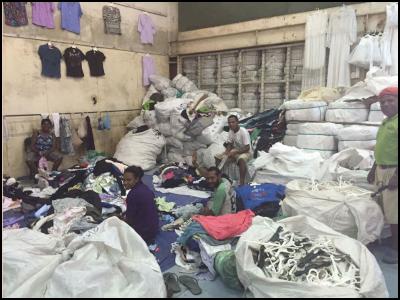Drowning In A Deluge Of Unwanted Clothing
Drowning In A Deluge Of Unwanted Clothing

Second hand clothing store
Kokopo, East New Britain, Papua New Guinea.
Photo
source: Clare Christian (Oct 2016)
Every year manufacturers are producing 80 billion garments - a 400% jump from just twenty years ago. New Zealanders are churning through near on $4 billion worth of clothing a year while our current solutions for end-of-life garments are limited. Up-cycling and re-engineering of clothing achieves about a 1% dent in our clothing consumption and while this model extends the wear-ability of a garment for a period it does not address what happens at its end-of-life. The choices we are left with is either redistribution of garments through charity shops (approximately 30% of donated clothing), offshoring to 3rd world countries (70% donated clothing) or landfilling.
Figures from the Ministry for the Environment show that 4% of landfill is textile waste. While 4% may not sound very much, this equates to one hundred million kilograms each year. According to the Department of Statistics a further 7.6 million kilograms of used donated clothing with an export value of $13.2 million was exported to Papua New Guinea in 2015. Effectively off-loading our used clothing problem onto a third world country with even less infrastructure than New Zealand.
This year East African Governments proposed a ban on the importation of second-hand clothes to their trading bloc. The importation of cheap used clothing has decimated local textile industries and created environmental issues in many countries. Africa’s move to ban second-hand clothing imports will mean wealthier countries will need to take more responsibility for their end of life clothing.
A raft of new documentaries (The true Cost, Thread, The Next Black) present a clothing system on the brink of collapse. While our seemingly insatiable appetite for new clothes shows no sign of slowing down, these figures do not include commercial textile consumption which is estimated to be 40 times greater than that of domestic use. We can start to comprehend the huge scale of the problem, but we do not have to wait until we are hurtling off the edge of a cliff before addressing it.
Help is on the horizon, there is considerable investment going into new technologies to recover the fibres from waste textiles. Europe and the United States are leading the charge driven by investment into circular economy initiatives to better utilise finite resources and reduce environmental impacts. These technologies while not quite mainstream yet, are quickly becoming available.
The Formary, a Wellington based textile research and development company, is working with some of New Zealand’s most prominent brands; Air New Zealand, Fonterra, New Zealand Post, SkyCity and The Warehouse Group, leading a multi stage Textile Reuse Programme. The focus of the programme is to create solutions that divert corporate textiles from landfill converting them into valued resource.
“People want to do the right thing, that’s why we see so many clothing donations to charities, but even they cannot keep up with the sheer volume of clothing and textiles we are consuming. We have the opportunity to do things better,converting textile waste into valuable feedstock for a range of industries makes good economic sense. It also assists the community by providing solutions that reduce ecological impacts” Bernadette Casey, The Formary’s Creative Director.
Bernadette Casey is a guest speaker at the 28th annual Waste Minimisation Conference being held in Wellington (17 to 20 October 2016) http://www.wasteminz.org.nz/news-events/events/conference/
Background:
80 billion garments manufactured each year:
http://truecostmovie.com/learn-more/environmental-impact/
The Guardian article explaining the business model of charity clothing:
https://www.theguardian.com/sustainable-business/sustainable-fashion-blog/2015/feb/13/second-hand-clothes-charity-donations-africa
East Africa Trading block has moved to ban second-hand clothing imports by 2019 in an attempt to revitalise its decimated textile industry.
http://www.sustainablebrands.com/news_and_views/waste_not/kelsey_halling/not_so_fast_fashion_african_countries_ban_secondhand_clothin
Kiwi corporates join forces to tackle textile waste:
Exporting our unwanted clothing to poorer countries is creating an environmental nightmare for 3rd world countries.
https://www.google.co.nz/search?q=Google+images&client=firefox-b-ab&source=lnms&tbm=isch&sa=X&ved=0ahUKEwj56-_p-KvPAhUCoZQKHWthBusQ_AUICCgB&biw=1280&bih=653&dpr=2 - tbm=isch&q=ukau+ukay+mountain&imgrc=zCBTVNXZ-xiwtM%3A


 Foodstuffs NZ: Foodstuffs Co-Ops To Examine ComCom's Full Decision Before Deciding On Merger Appeal
Foodstuffs NZ: Foodstuffs Co-Ops To Examine ComCom's Full Decision Before Deciding On Merger Appeal Plant and Food Research: World First Discovery Shows New Molecule In New Zealand Blackcurrants Inhibits An Enzyme That Degrades Dopamine
Plant and Food Research: World First Discovery Shows New Molecule In New Zealand Blackcurrants Inhibits An Enzyme That Degrades Dopamine The Reserve Bank of NZ: Liquidity Management - Principles For Liquidity Provision & The End Of An Abundant Era
The Reserve Bank of NZ: Liquidity Management - Principles For Liquidity Provision & The End Of An Abundant Era Bill Bennett: Broadband marketing rules to cut confusion
Bill Bennett: Broadband marketing rules to cut confusion Citizens Advice Bureau: Migrant Workers Will Suffer From Change To Exploitation Visa
Citizens Advice Bureau: Migrant Workers Will Suffer From Change To Exploitation Visa Parrot Analytics: Netflix Leapfrogs Legacy Studio In Key Metric For First Time
Parrot Analytics: Netflix Leapfrogs Legacy Studio In Key Metric For First Time



